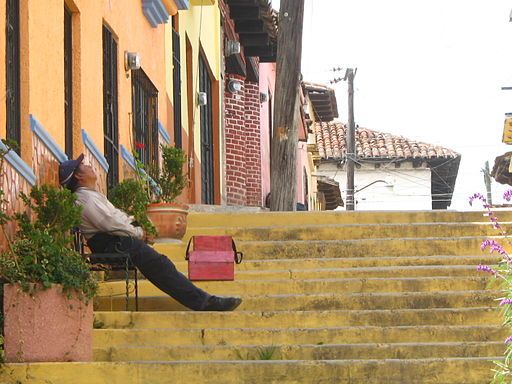
[dt_button link=”http://d165vjqq8ey7jy.cloudfront.net/mp3/33070/se-8252s.mp3″ target_blank=”true” button_alignment=”default” animation=”fadeIn” size=”small” style=”default” bg_color_style=”custom” bg_color=”#333333″ bg_hover_color_style=”custom” bg_hover_color=”#444444″ text_color_style=”custom” text_color=”#ffffff” text_hover_color_style=”custom” text_hover_color=”#dddddd” icon=”fa fa-cloud-download” icon_align=”left”]Yuklash[/dt_button]
[dt_divider style=”thin” /]
The Spanish Siesta
Voice 1
Welcome to Spotlight. I’m Adam Navis.
Voice 2
And I’m Anne Muir. Spotlight uses a special English method of broadcasting. It is easier for people to understand, no matter where in the world they live.
Voice 1
What time do you usually go to bed? How many hours do you sleep each night? Do you ever wake up in the middle of the night?
Voice 2
Sleeping traditions may be stranger than you know. For example, in the past, some people had two different sleeps every night. They would wake up in the middle of the night to talk, or pray or do quiet activities. But today, most people just have one sleep for about eight hours at night. However, there is no correct way to get enough sleep in a day. People around the world have different customs for sleeping at night, and during the day. Today’s Spotlight is on one particular sleep tradition called the siesta.
Voice 1
Siesta is a Spanish word. It means “nap” or short sleep. In this custom people sleep for a short time after eating their mid-day meal. A sleep like this is often a tradition in places where it is very hot in the middle of the day. People work in the morning and then rest. Then, after their siesta, they go back to work until later in the evening.
Voice 2
The siesta is a tradition from Spain. But other places also have this custom, including other Mediterranean countries in Southern Europe. People in countries with Spanish influence may also take siestas, like in the Philippines and some Latin American countries. In this program, we will look at the siesta in Spain and how it may change in the future.
Voice 1
Normal working hours are different in different places around the world. In some countries, many people start work at 7:00 a.m. – in the morning – and do not come home until 7:00 p.m. – at night. In other countries, workers are expected to work from nine a.m. until five p.m.
Voice 2
But in Spain, many people start work at 8:00 or 9:00 in the morning. Then offices close for a couple hours in the afternoon at about 2:00. And people go back to work from about five until eight or nine at night.
Voice 1
This system began when Spain was an agricultural country. Many people worked outside in the field. These workers could not work well in the early afternoon. It was too sunny and hot. So they took a long break after eating lunch until it was cooler. But today, the economy of Spain is no longer mainly agricultural. People do not need to break when it is hot. But some people still take a break in the middle of the day.
Voice 2
Some people think that the siesta is a good custom. It gives people time to rest in the middle of the day. And there is some scientific evidence that taking naps can make people’s bodies and minds work better. The National Aeronautics and Space Administration or NASA did a famous scientific study in the 1990s. They studied how airplane pilots performed after they took naps and when they did not nap. NASA found that naps provided a 34% increase in pilot performance. Naps also provided a 100% increase in physiological alertness. Of course, not everyone needs to be as alert, or awake and able to react quickly as the pilot of an airplane! But many individuals, organizations and companies are interested in how to make people happy and able to work hard.
Voice 1
Even though a siesta might be helpful, it does not work for everyone. Some businesses do not let people stop working. Some people live far from the city and cannot go home during the day. Other people use the time to do small personal errands or shopping. The result is that a lot of people in Spain are not getting enough sleep.
Voice 2
The people of Spain also get less sleep because of Spain’s special time. Spain is one hour ahead of the countries around it. In the 1940s, Spain’s leader changed the country’s time to match with Germany. And since then Spain has not changed its official time. The Parliament of Spain studied this issue. They released a document that explained why this was a problem:
Voice 3
“We sleep almost an hour less than the World Health Organization suggests. All this has a negative effect on productivity, missing days of work, stress, accidents and the rates of people leaving school. Our day is influenced more by the sun than by the clock. We eat at 1:00 in the afternoon and at eight in the evening, by the sun. But the clock says it is 3:00 and 10:00.”
Voice 1
People in Spain are talking about changing the official time of the country. They are also talking about changing the hours of the working day. This would take away the siesta. The Prime Minister of Spain is Mariano Rajoy. In 2016, he suggested moving the hours of the working day so that people can go home earlier.
Voice 2
Some people think that this is a good idea. They think that if people end work earlier they will get more sleep. People may also be able to take better care of their families. It can be difficult to care for children in the evening if parents have to work until later.
Voice 1
Spain has struggled with this problem for a few years. Ignacio Buqueras is a Spanish economist who supports changing working hours. He thinks that without a siesta, Spain will have a better economy that can produce more with less effort. In 2014, he told the New York Times newspaper:
Voice 4
“We want to see a more efficient culture. Spain has to break the bad habits that have increased over the past 40 or 50 years.
Voice 2
But siesta time is also very important for the culture of Spain. During the siesta, families take time to eat together. Friends spend hours talking. Without a siesta, this time is gone. There are both good and bad things about siesta time. But one thing is certain – it is difficult to change the schedule of a whole country!
Voice 1
What are normal working hours where you live? Would you take a siesta if you could? You can leave a comment on our website. Or email us at radio@radioenglish.net. You can also comment on Facebook at Facebook.com/spotlightradio.
Voice 2
The writer of this program was Rena Dam. The producer was Michio Ozaki. The voices you heard were from the United States and the United Kingdom. All quotes were adapted for this program and voiced by Spotlight. You can listen to this program again, and read it, on the internet at www.radioenglish.net. This program is called, ‘The Spanish Siesta’.
Voice 1
Look for our listening app in the Google Play Store and in iTunes. We hope you can join us again for the next Spotlight program. Goodbye.



